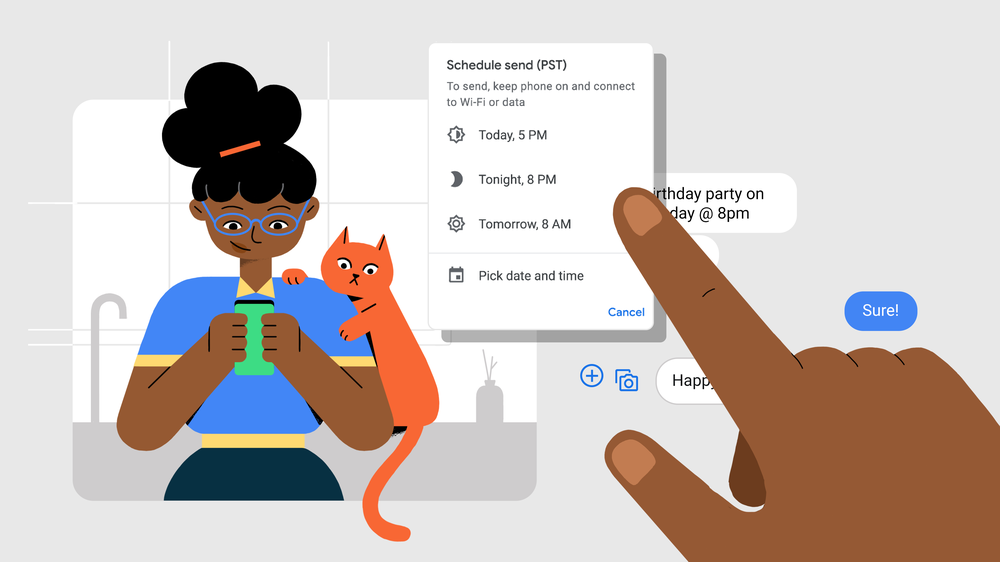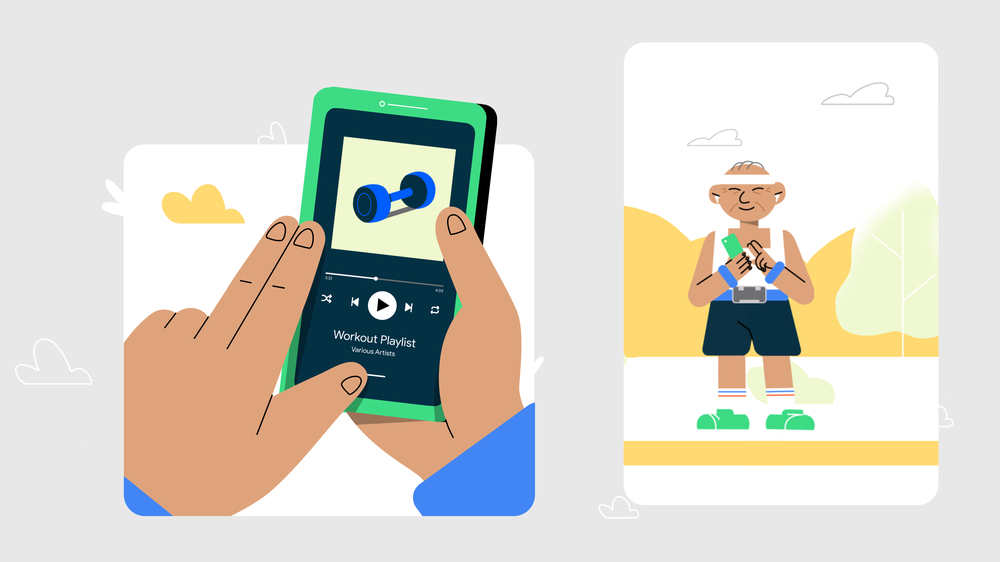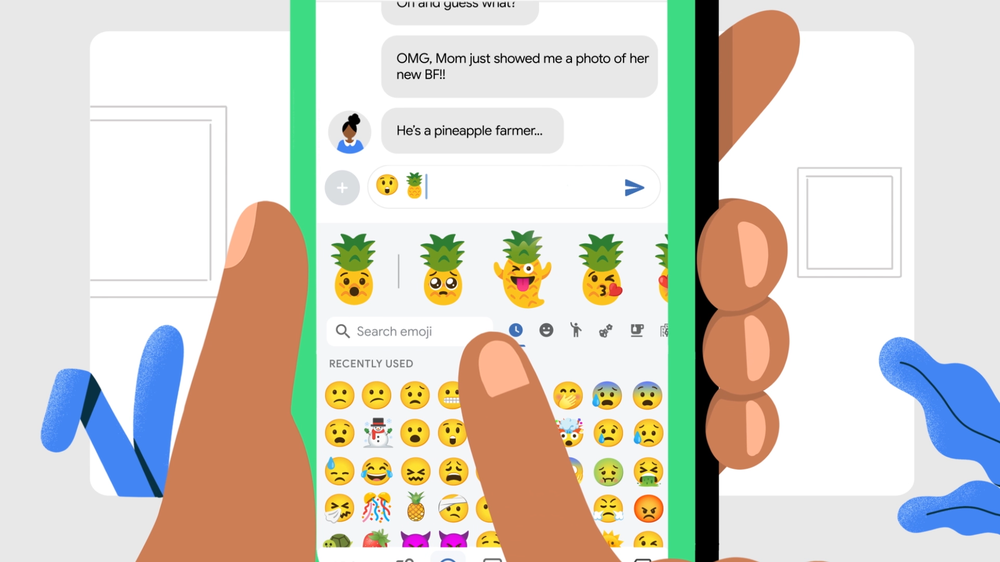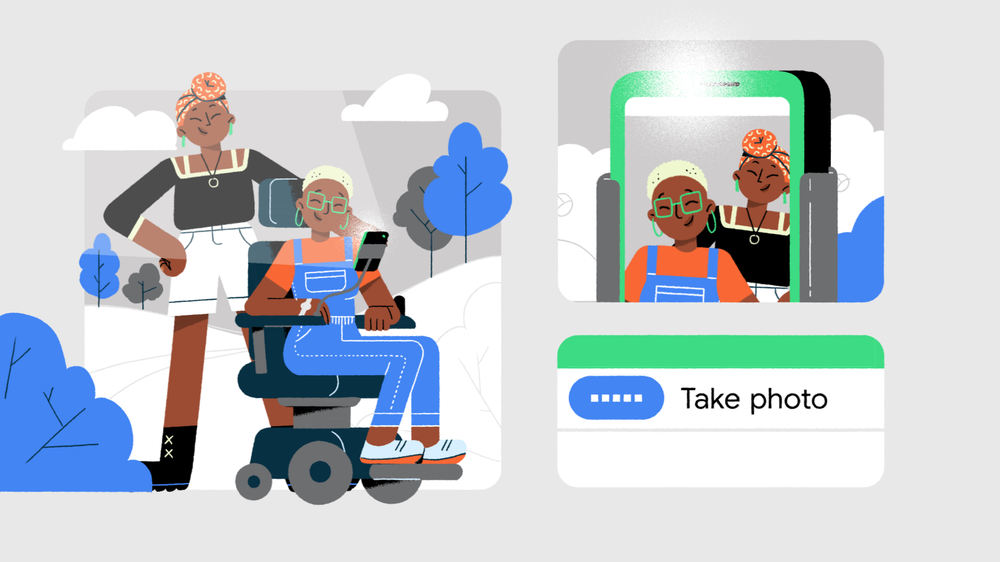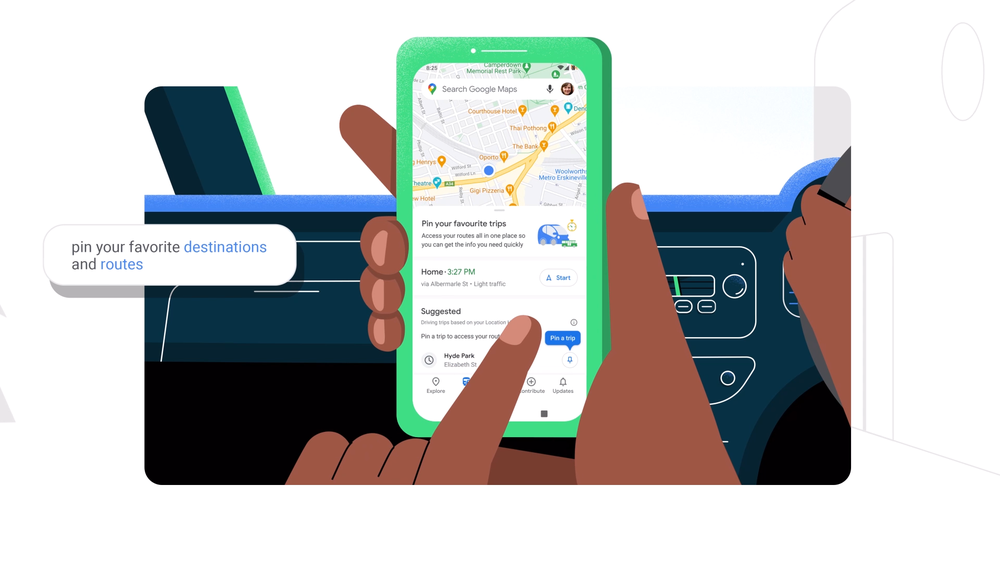Tag: Accessibility
8 new accessibility updates across Lookout, Google Maps and more
by Eve Andersson on May.17, 2024, under 3D Models, Argentina, Australia, Brazil, California, Denmark, England, Germany, Google Earth News, Google Earth Tips, Google Sky, Google maps, Hawaii, Indonesia, Ireland, Italy, Japan, Kenya, Mexico, Natural Landmarks, Netherlands, Sightseeing, Street Views, USA
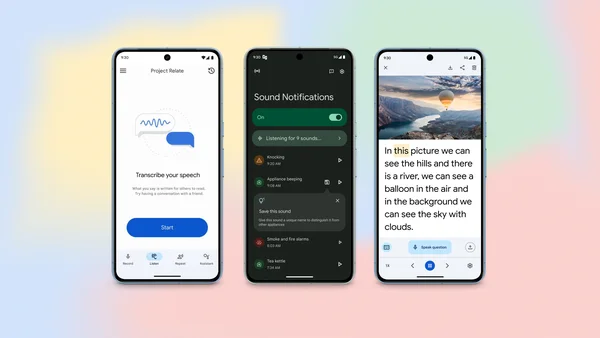 For Global Accessibility Awareness Day, here’s new updates to our accessibility products.
For Global Accessibility Awareness Day, here’s new updates to our accessibility products.8 ways we’re making daily tasks more accessible
by Eve Andersson on Oct.18, 2023, under 3D Models, Argentina, Australia, Brazil, California, Denmark, England, Germany, Google Earth News, Google Earth Tips, Google Sky, Google maps, Hawaii, Indonesia, Ireland, Italy, Japan, Kenya, Mexico, Natural Landmarks, Netherlands, Sightseeing, Street Views, USA
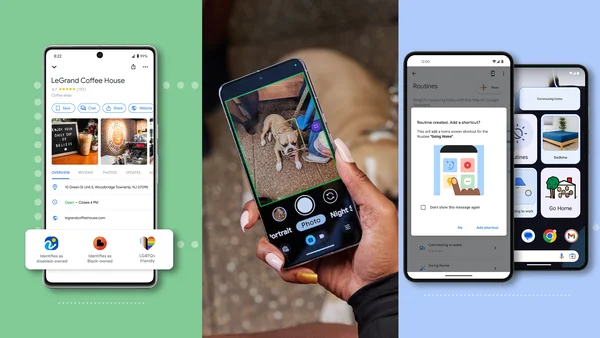 Today, we’re launching new products and features aimed at making daily tasks more accessible for people with disabilities.
Today, we’re launching new products and features aimed at making daily tasks more accessible for people with disabilities.Plan and find your way in stations with new, accessible Maps tools
by Ramesh Nagarajan on May.26, 2021, under 3D Models, Argentina, Australia, Brazil, California, Denmark, England, Germany, Google Earth News, Google Earth Tips, Google Sky, Google maps, Hawaii, Indonesia, Ireland, Italy, Japan, Kenya, Mexico, Natural Landmarks, Netherlands, Sightseeing, Street Views, USA
Train stations are often busy, bustling places. Whether you’re reaching your final stop or catching a connection, finding your way through a complex or crowded station can be daunting. And for people traveling with wheelchairs, luggage, prams or crutches, there are even more factors to juggle.
In 2018, we brought wheelchair accessible routes to Sydney and other cities around the world. To build on this, we’ve been working with Transport for NSW to help people map out each stage of the journey inside the station.
To help people map out their journeys ahead of time, we’re launching indoor Street View imagery for 130 train stations and a dozen metro stations in Sydney. Starting today, you’ll be able to virtually navigate interactive, panoramic imagery inside Sydney stations, so you’ll know your way when you get there. You can also enjoy the rich history and beauty of many stations, from heritage listed St James Station, to the stunning views of Circular Quay and Milsons Point – and the thriving hub of Parramatta.
For the first time in Australia, we’re also bringing detailed navigation directions for accessible routes across 70 complex train and metro stations across Sydney to Google Maps. These tools allow people to find the best and most accessible entrances, exits, signage and paths within the station and better anticipate in-transit travel times along these pathways.
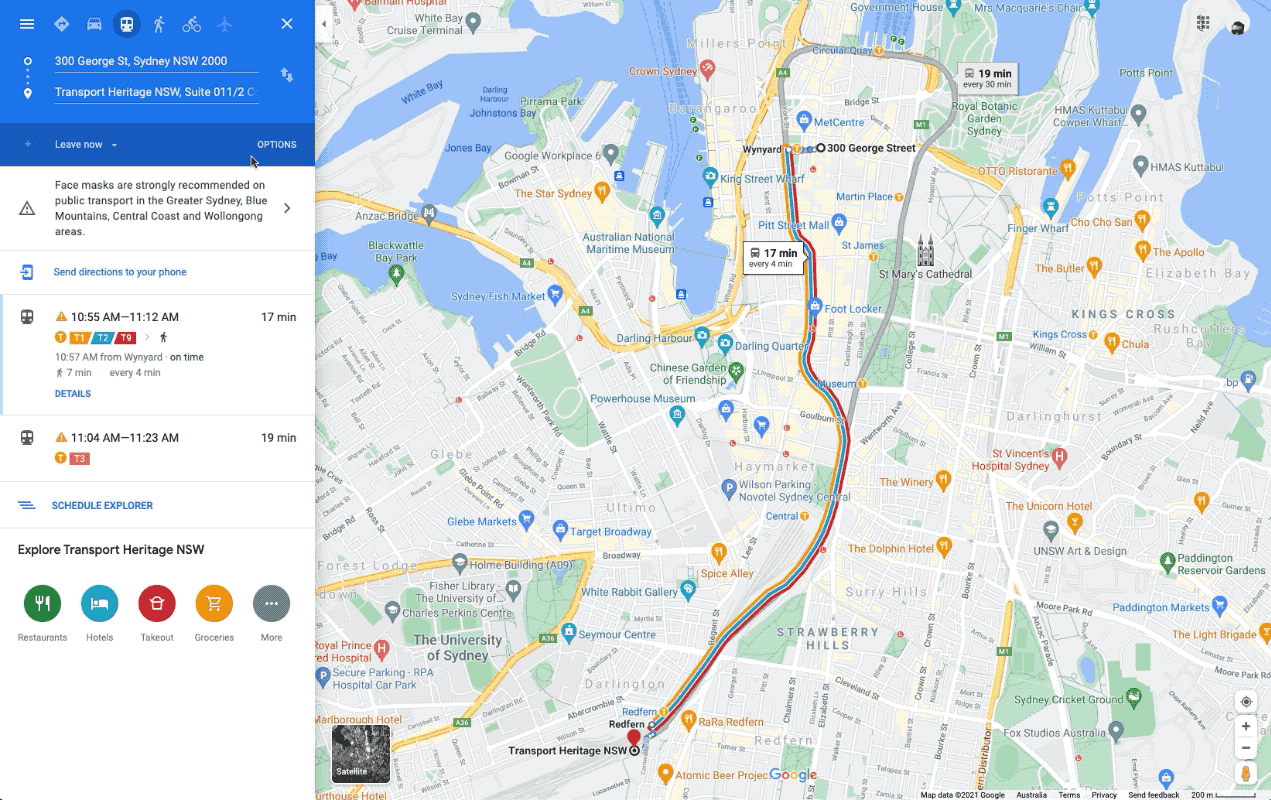
Accessible navigation directions on Google Maps on desktop
And as a world first, we’re sharing these navigation directions with Transport for NSW so it can be published to the NSW government’s Open Data Portal. This will allow the transport industry and app developers to access this valuable information and find more solutions to enable accessible transit travel in the future.
To find these accessible navigation directions for your route on desktop or mobile, type your destination into Google Maps. Tap “Directions”, then select the public transport icon and any route options (such as “wheelchair accessible”, “fewer transfers” and “less walking”). After you tap your chosen route, the detailed navigation instructions will be displayed if your route takes you through a complex station in Sydney.
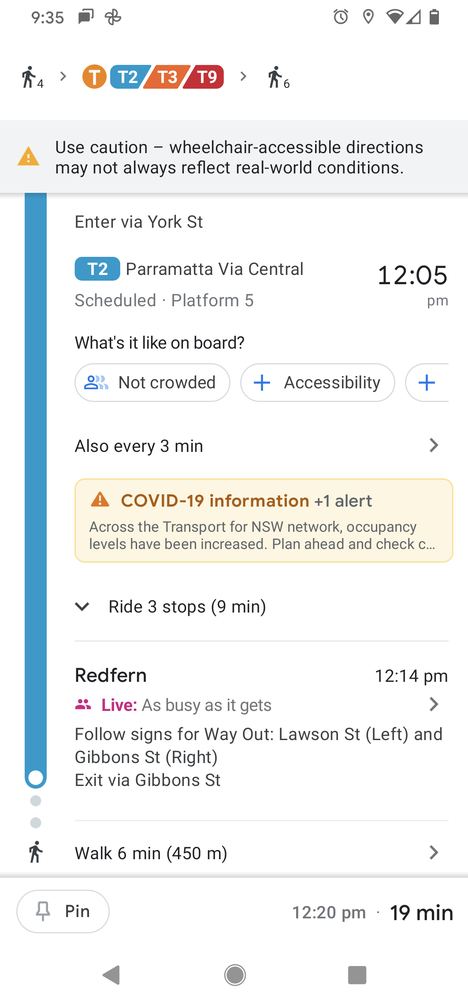
Accessible in-station directions in mobile view
Whether you are planning or navigating your commute, we hope these tools make Sydney stations feel a little more familiar – and help you commute with more confidence.
How anyone can make Maps more accessible
by Mara Chomsky on May.20, 2021, under 3D Models, Argentina, Australia, Brazil, California, Denmark, England, Germany, Google Earth News, Google Earth Tips, Google Sky, Google maps, Hawaii, Indonesia, Ireland, Italy, Japan, Kenya, Mexico, Natural Landmarks, Netherlands, Sightseeing, Street Views, USA
With Google Maps, we want to make it easier to get around, explore and get things done for everyone — and that includes people with disabilities. One way that we make sure our Maps have up-to-date information about details, like if a restaurant has tables suitable for people who use wheelchairs, is through our community of Local Guides. In honor of Global Accessibility Awareness Day, we’re sharing tips from some of these people about how anyone can contribute to a more accessible world — both on and off of the map.
Make an accessibility checklist for your reviews
When you add a review on Google Maps you can create your own template or accessibility checklist to make sure you have the most helpful details covered.
Tushar Suradkar, a Local Guide from India, created a system that helps him make sure all of his reviews covers the accessibility details he cares about — like if a place has tactile paths for the visually impaired, ramp access, and wheelchair-accessible entrances, restrooms, parking and elevators. Each time he leaves a review, he fills in a self-created template that makes these details clear and noticeable so people looking for this information can spot it.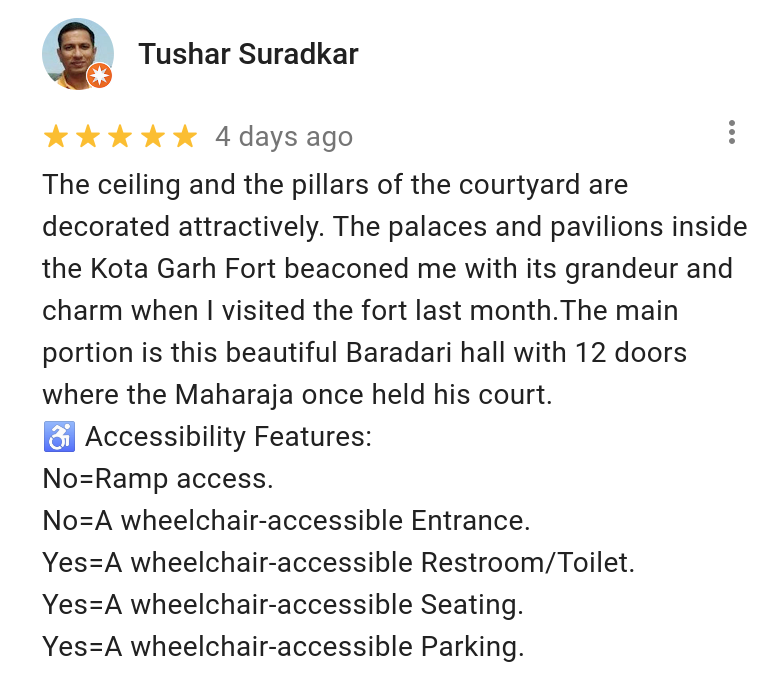
Tushar’s accessibility checklist used on Google Maps reviews.
Add accessibility attributes to your business or places you’ve visited
After visiting a place or business, you can help indicate which accessibility features a place has — like whether it has a wheelchair-accessible entrance, wheelchair-accessible restroom, wheelchair-accessible parking — by answering questions about the business on the Google Maps app.
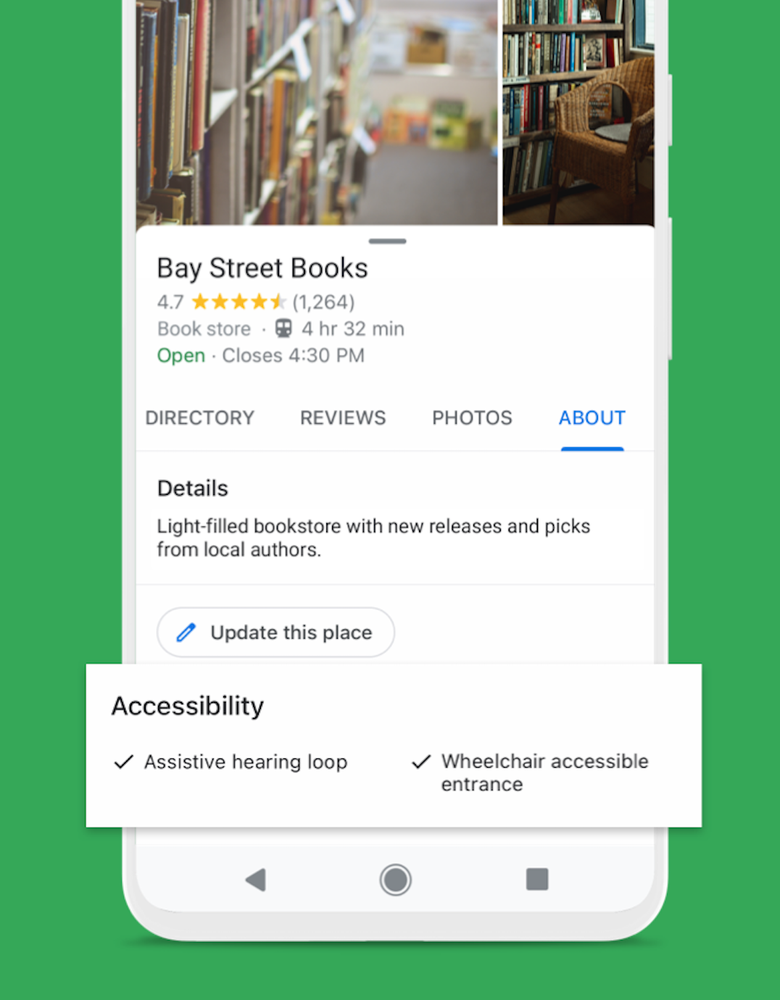
Accessibility attributes displayed on Google Maps.
Create lists to curate accessible places on Google Maps
Another way to share local knowledge is by creating public lists on Google Maps. You can make lists of places like accessible museums in your city or the most wheelchair accessible restaurants in your neighborhood.
Asongfac Lily Rospeen, a Local Guide from the Southwest region of Cameroon, curates lists like her Accessibility Buea list that includes wheelchair accessible banks, hotels, hospitals, bookshops, pharmacies, and supermarkets in her city.Spread the word about accessibility
Let others know about all the ways they can contribute to Maps to make it more accessible through attributes, reviews and more. Take inspiration from the Local Guides community.
Emeka Ulor, a Local Guide from Nigeria, has rallied other people to add accessibility data to Google Maps and help make it more inclusive. He started the One Accessibility project, recruiting more than 20 volunteers and hosting more than 100 meet-ups to encourage people to add accessibility information to Google Maps. His reviews include information about wheelchair accessible parking, entrances, restrooms, lighting, Braille and seating to help inform people about the accessibility of their destination.
You can read more about these Local Guides and how others in the community are making Google Maps more accessible on Connect, our blog and forum for Local Guides.Your Android is now even safer — and 5 other new features
by Hideaki Oshima on Feb.24, 2021, under 3D Models, Argentina, Australia, Brazil, California, Denmark, England, Germany, Google Earth News, Google Earth Tips, Google Sky, Google maps, Hawaii, Indonesia, Ireland, Italy, Japan, Kenya, Mexico, Natural Landmarks, Netherlands, Sightseeing, Street Views, USA
It wasn't all that long ago that we introduced Android users to features like Emoji Kitchen and auto-narrated audiobooks. But we like to stay busy, so today we're highlighting six of the latest Google updates that will make Android phones more secure and convenient — for everyone.
1. Keep your accounts safe with Password Checkup on Android
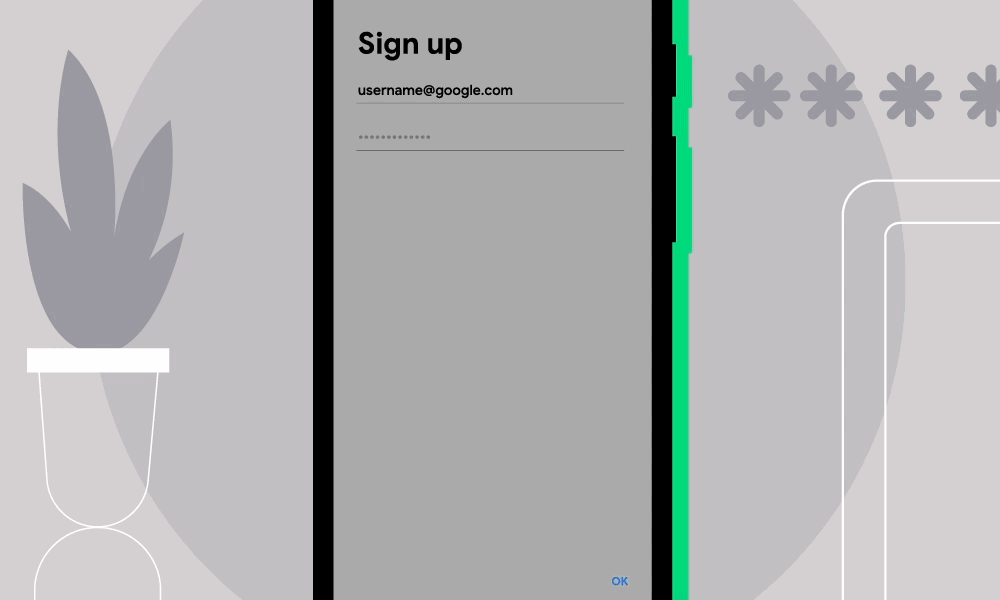
Password Checkup notification screen
On Android, you can save passwords to your Google account, making it quicker and easier to sign into your apps and services using Autofill. Your login credentials are one of your first lines of defense against intruders, so we’ve integrated Password Checkup into devices running Android 9 and above. This feature lets you know if the password you used has been previously exposed and what to do about it.
Now when you enter a password into an app on your phone using Autofill with Google, we’ll check those credentials against a list of known compromised passwords — that is, passwords that have potentially already been stolen and posted on the web. If your credentials show up on one of these lists, we’ll alert you and guide you to check your password and change it.
Learn more on our support page about changing unsafe passwords. And you can find additional information about how this product works in this blog post.
We’re passionate about building defense into every detail on Android, from downloading apps to browsing the web to choosing where and when you share your data. Learn more about how Android keeps you safe.
2. Use schedule send in Messages to write a text now and send it later
Over half a billion people across the world use Messages to seamlessly and safely connect with family, friends and others every month. To continue improving the way you communicate and help you stay in touch, we’re starting to roll out schedule send in Messages for phones running Android 7 and newer.
Having loved ones in another time zone or on a different schedule can sometimes make it difficult to send a text at an appropriate time. With schedule send, you can compose a message ahead of time when it’s convenient for you, and schedule it to send at the right moment. Just write your message as you normally would, then hold and press the send button to select a date and time to deliver your message. Download Messages or update to the latest version to schedule your next text.
3. No need to look at your screen, with TalkBack
For those who are blind or have trouble seeing the display, the new version of TalkBack, Android’s screen reader, is now available. Using spoken feedback and gestures, TalkBack makes Android even more accessible and opens up a full phone experience without needing to look at your screen. We worked closely with the blind and low vision communities on this revamp of TalkBack to incorporate the most popularly requested features including: more intuitive gestures, a unified menu, a new reading control menu and more. Get TalkBack today by downloading or updating your Android accessibility apps in the Google Play Store.
4. Get more done hands-free with Google Assistant
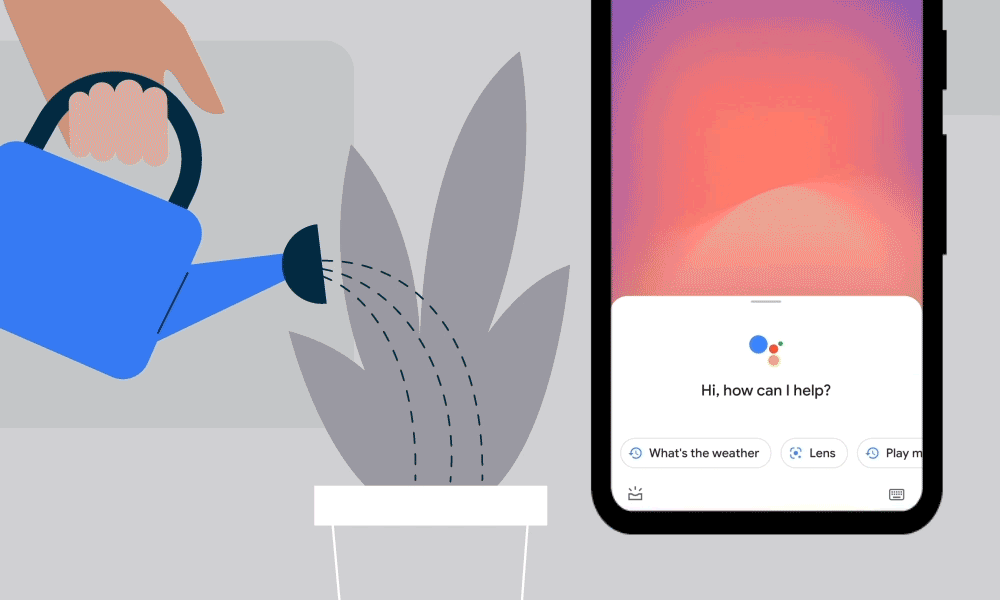
Use Google Assistant to send a text, even when your phone is locked
We want to give you more ways to use your phone hands-free — so you can do things like use your voice to make calls, set timers or alarms and play music. Now, the latest updates to Google Assistant make it easier to get things done on your phone without needing to be right next to it.
Assistant now works better even when your phone is locked or across the room with new cards that can be read with just a glance. Just say “Hey Google, set an alarm” or “Hey Google, play pop music on Spotify.” To get the most out of Assistant when your phone is locked, simply turn on Lock Screen Personal Results in Assistant setting and say “Hey Google '' to send text messages and make calls.
5. Come to the dark side with dark theme in Google Maps
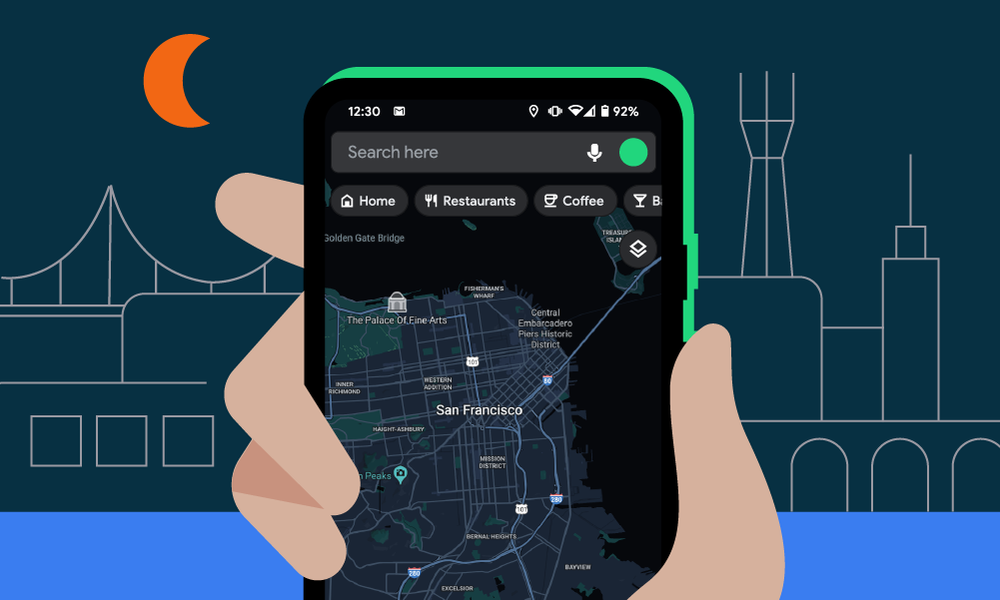
San Francisco on Google Maps dark theme
These days, we’re all experiencing a bit of screen fatigue. With dark theme in Google Maps soon expanding to all Android users globally, you can give your eyes a much-needed break and save on battery life. Simply head to your Settings, tap on Theme and then on “Always in Dark Theme” to lower the lights when you’re navigating, exploring, or getting things done with Maps. Change your mind? Just tap on “Always in Light Theme” to switch it back.
6. A better drive with Android Auto
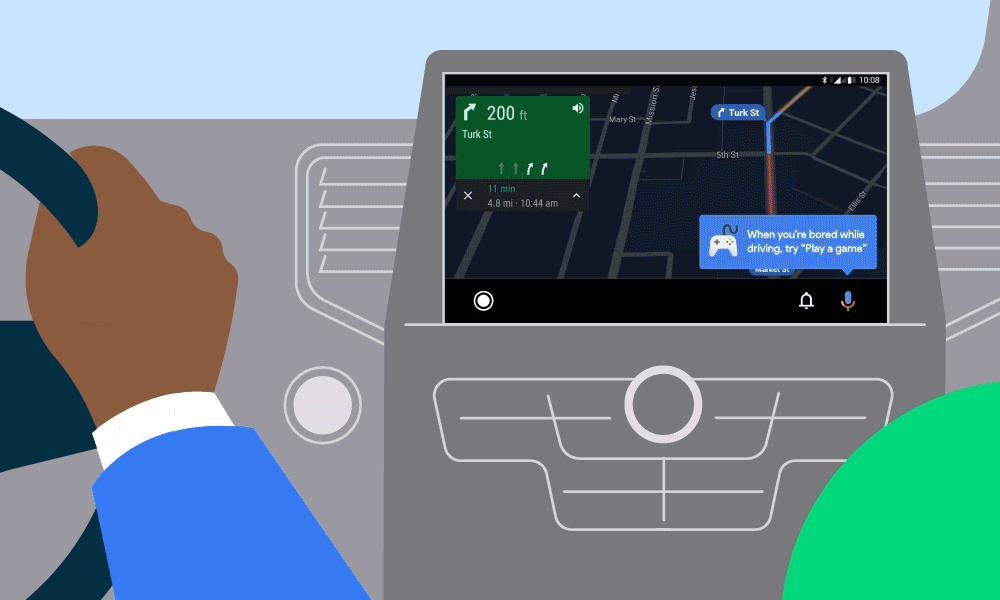
Stay entertained with voice-activated games on your display with Android Auto
Android Auto’s new features help you enjoy the drive more. With custom wallpapers, you can now select from a variety of car-inspired backgrounds to personalize your car display. For longer drives, you and your passengers can stay entertained with voice-activated games like trivia and “Jeopardy!” Just say, “Hey Google, play a game” to get started.
We’ve also launched shortcuts on the launch screen. These provide convenient access to your contacts and even allow you to use Assistant to complete tasks like checking the weather or remotely adjusting the thermostat by simply tapping on the icon on your car display, just as you would on your phone. For cars with wider screens, you can do more with a split-screen that features a real-time view of Google Maps and media controls. And if you have family and friends coming along for the ride, you can now set a privacy screen to control when Android Auto appears on your car display.
These Android Auto features will be available in the coming days on phones running Android 6.0 or above, and when connected to your compatible car.
6 new ways Android can help this holiday season
by Ajay Gokhale on Dec.04, 2020, under 3D Models, Argentina, Australia, Brazil, California, Denmark, England, Germany, Google Earth News, Google Earth Tips, Google Sky, Google maps, Hawaii, Indonesia, Ireland, Italy, Japan, Kenya, Mexico, Natural Landmarks, Netherlands, Sightseeing, Street Views, USA
With the holidays around the corner, we’re sharing six new Google features for Android—a few more ways your phone gets more helpful over time, even outside of major OS updates. Whether you’re texting holiday greetings to loved ones or winding down with a book, here’s how Android can help.
1. Mix up more of your favorite emoji
With Emoji Kitchen on Gboard, people have mixed their favorite emoji into customized stickers over 3 billion times since it was released earlier this year. With this latest update, Emoji Kitchen is going from hundreds of unique design combinations to over 14,000. Each mix makes it easier for you to express yourself with a little extra flair. Now you can simply tap two emoji to quickly see suggested combinations, or double tap on one emoji to reveal some more intense emotions.
Already available on Gboard beta, the new version of Emoji Kitchen will be available on Android 6.0 and above over the coming weeks. Download Gboard on Google Play to enjoy the new emoji kitchen stickers this holiday season. ❄️️⛄️
2. Enjoy more stories as audiobooks
The holiday season is the perfect time to wind down and catch up on some books, and audiobooks make it even more convenient to immerse yourself in a story. But not all books, like the one written by your favorite indie author, are converted into an audiobook. Now Google Play, working with publishers in the U.S. and the UK, will use auto-generated narrators so books without audio versions can be narrated—meaning you’ll have more audio titles to choose from on Play Store. The publisher tool to create auto-narrated audiobooks is currently in beta, but it will roll out to all publishers in early 2021.
3. Use Voice Access to navigate your device
Built with people with motor disabilities in mind, Voice Access lets you control your phone using your voice. Now using machine learning technology, you can add labels to the screens of your Android apps to help you work within them with your voice. For example, you can say “open Photos”, “tap Search”, “tap Your Map” to see a map of all your photos. This makes navigation convenient and hands-free, using just your voice. Previously rolled out on Android 11, this new version of Voice Access is now available globally on all devices running Android 6.0 and above. You can download Voice Access on Google Play and try the new version out by joining the Beta today.
4. Get around with the Go Tab
With the new Go Tab in Google Maps, you can more easily navigate to frequently-visited places with just one tap. Pin your favorite driving destinations like school or a grocery store to quickly see directions, live traffic trends, disruptions on your route, and an accurate ETA—all without typing the place’s address. If you take public transit, you can pin specific routes, which will let you see accurate departure and arrival times, alerts from your local transit agency, and an up-to-date ETA right from the Go Tab. You can even pin multiple routes (including a driving route and a transit route) to the same destination to see which one will get you there most efficiently. The Go Tab starts rolling out on Android and iOS in the coming weeks.
Be sure to check out other helpful Google Maps features on Android, like live transit crowdedness and Assistant driving mode to help you navigate and get things done this holiday season.
5. Android Auto expands to more countries

Over the next few months, Android Auto will be expanding to new countries, bringing your favorite apps and services from your phone onto your car display. With Android Auto, you can talk to Google to play music, send messages, get directions, and more, so you can keep your eyes on the road and your hands on the wheel. With phones running Android 10 and above, all you need to do to get started is plug your Android phone into a compatible car. For Android 9 and earlier phones, you can download the app.
6. Share your favorite apps with Nearby Share
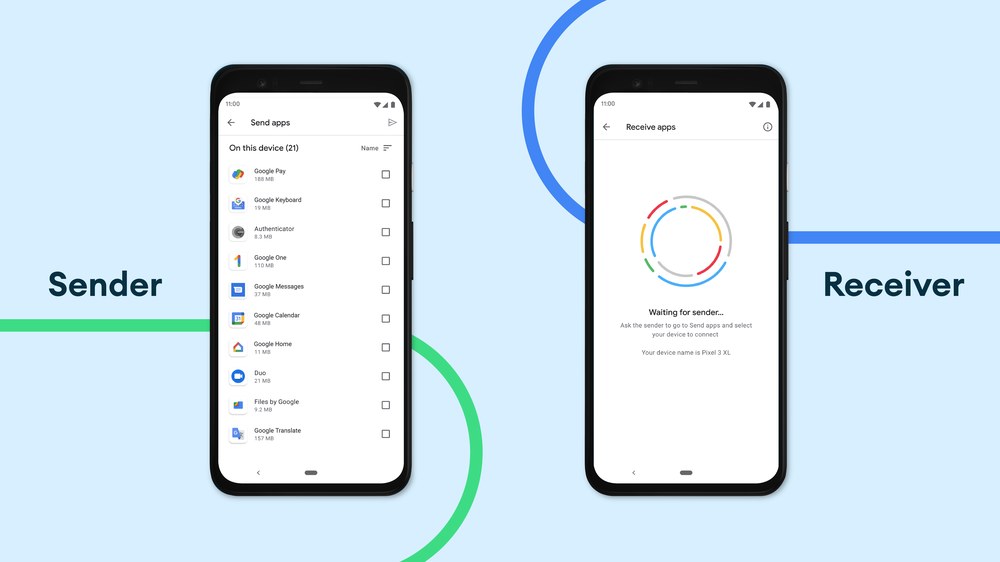
An upcoming update to Nearby Share will let you share apps from Google Play with the people around you with an Android phone, even if you don’t have a cell or Wi-Fi connection. Simply open Google Play, go to the “Share Apps” menu in “My Apps & Games,” select the apps you want to share, and let your friend accept the incoming apps. This update will roll out in the coming weeks.
Find wheelchair accessible places with Google Maps
by Sasha Blair-Goldensohn on May.22, 2020, under 3D Models, Argentina, Australia, Brazil, California, Denmark, England, Germany, Google Earth News, Google Earth Tips, Google Sky, Google maps, Hawaii, Indonesia, Ireland, Italy, Japan, Kenya, Mexico, Natural Landmarks, Netherlands, Sightseeing, Street Views, USA
Editor’s note: Today is Global Accessibility Awareness Day, and we’ll be sharing resources and tools for education, as well as accessibility features and updates for Android and Google Maps.
Imagine making plans to go somewhere new, taking the journey to get there and arriving— only to be stuck outside, prevented from sitting with family or being unable to access the restroom. It’s a deeply frustrating experience I’ve had many times since becoming a wheelchair user in 2009. And it’s an experience all too familiar to the 130 million wheelchair users worldwide and the more than 30 million Americans who have difficulty using stairs.
So imagine instead being able to “know before you go” whether a destination is wheelchair accessible, just as effortlessly as looking up the address. In recognition of Global Accessibility Awareness Day, we’re announcing a new Google Maps feature that does just that.
People can now turn on an “Accessible Places” feature to have wheelchair accessibility information more prominently displayed in Google Maps. When Accessible Places is switched on, a wheelchair icon will indicate an accessible entrance and you’ll be able to see if a place has accessible seating, restrooms or parking. If it’s confirmed that a place does not have an accessible entrance, we’ll show that information on Maps as well.
Better maps for everyone, whether you walk or roll
Today, Google Maps has wheelchair accessibility information for more than 15 million places around the world. That number has more than doubled since 2017 thanks to the dedication of more than 120 million Local Guidesand others who’ve responded to our call to share accessibility information. In total, this community has contributed more than 500 million wheelchair accessibility updates to Google Maps. Store owners have also helped, using Google My Business to add accessibility information for their business profiles to help users needing stair-free access find them on Google Maps and Search.
With this feature “rollout”, it’s easier to find and contribute wheelchair accessibility information to Google Maps. That benefits everyone, from those of us using wheelchairs and parents pushing strollers to older adults with tired legs and people hauling heavy items. And in this time of COVID-19, it’s especially important to know before you go so that you won’t be stranded outside that pharmacy, grocery or restaurant.
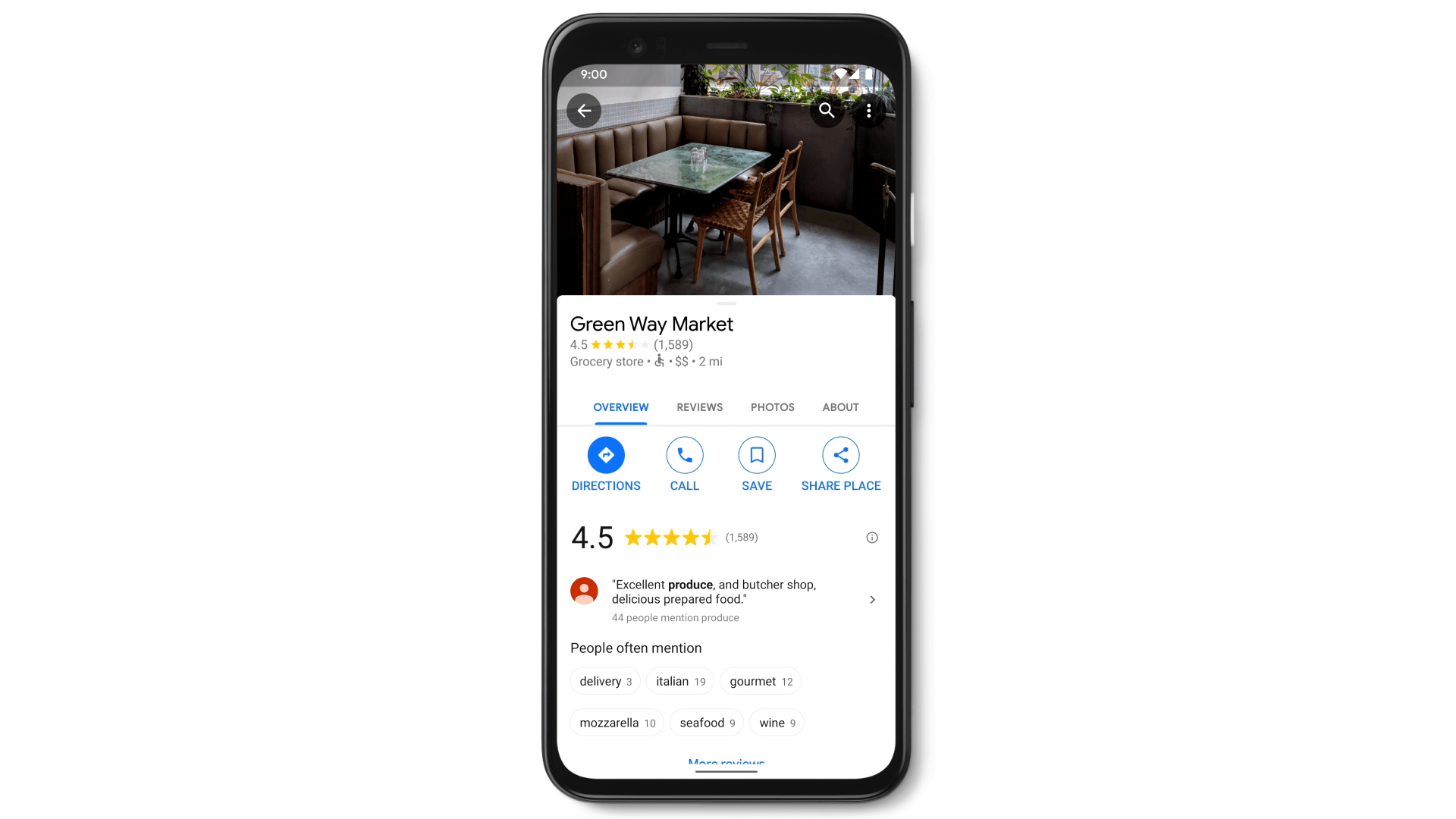
Anyone can contribute accessibility information to Google Maps
To get wheelchair accessibility information more prominently displayed in Google Maps, update your app to the latest version, go to Settings, select “Accessibility,” and turn on “Accessible Places.” The feature is available on both Android and iOS.
We’re also rolling out an update that allows people using iOS devices to more easily contribute accessibility information, joining the millions of Android users who have been sharing this type of information on Maps. This guide has tips for rating accessibility, in case you’re not sure what counts as being “accessible.” We invite everyone to switch on Accessible Places and contribute accessibility information to help people in your community.
A Maps milestone, built on a movement
This launch is a milestone in our journey to build a better, more helpful map for everyone, which includes recent efforts to help people find accessible places, transit routes and walking directions. Our work wouldn’t be possible without the decades of advocacy from those who have fought for equal access for people with disabilities. Were it not for them, there would be far fewer accessible places for Google Maps to show.
The Accessible Places feature is starting to rollout for Google Maps users in Australia, Japan, the United Kingdom and the United States, with support for additional countries on the way.
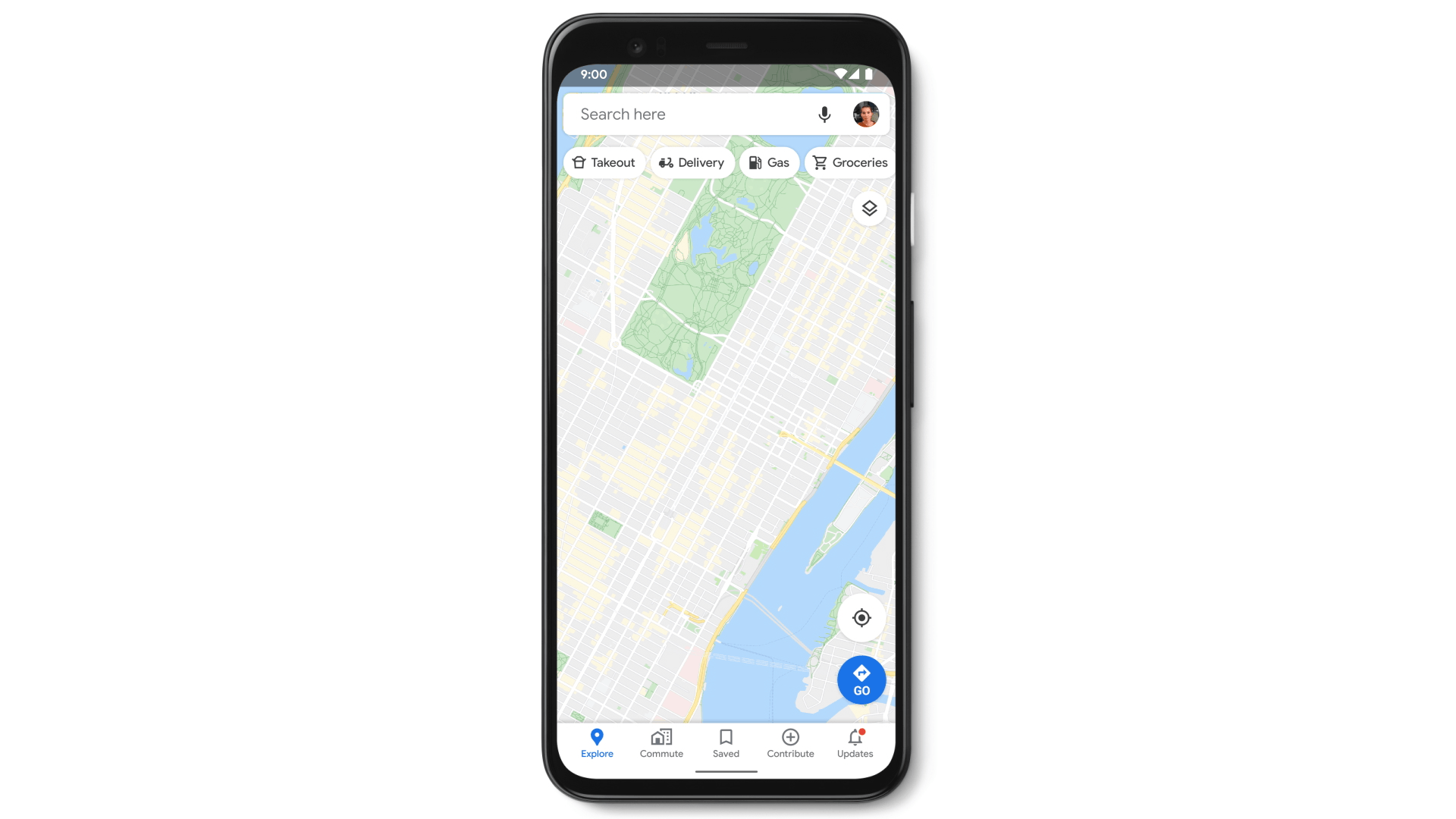
Use the Accessible Places feature to see accessibility information more prominently displayed in Google Maps
Find wheelchair accessible places with Google Maps
by Sasha Blair-Goldensohn on May.22, 2020, under 3D Models, Argentina, Australia, Brazil, California, Denmark, England, Germany, Google Earth News, Google Earth Tips, Google Sky, Google maps, Hawaii, Indonesia, Ireland, Italy, Japan, Kenya, Mexico, Natural Landmarks, Netherlands, Sightseeing, Street Views, USA
Editor’s note: Today is Global Accessibility Awareness Day, and we’ll be sharing resources and tools for education, as well as accessibility features and updates for Android and Google Maps.
Imagine making plans to go somewhere new, taking the journey to get there and arriving— only to be stuck outside, prevented from sitting with family or being unable to access the restroom. It’s a deeply frustrating experience I’ve had many times since becoming a wheelchair user in 2009. And it’s an experience all too familiar to the 130 million wheelchair users worldwide and the more than 30 million Americans who have difficulty using stairs.
So imagine instead being able to “know before you go” whether a destination is wheelchair accessible, just as effortlessly as looking up the address. In recognition of Global Accessibility Awareness Day, we’re announcing a new Google Maps feature that does just that.
People can now turn on an “Accessible Places” feature to have wheelchair accessibility information more prominently displayed in Google Maps. When Accessible Places is switched on, a wheelchair icon will indicate an accessible entrance and you’ll be able to see if a place has accessible seating, restrooms or parking. If it’s confirmed that a place does not have an accessible entrance, we’ll show that information on Maps as well.
Better maps for everyone, whether you walk or roll
Today, Google Maps has wheelchair accessibility information for more than 15 million places around the world. That number has more than doubled since 2017 thanks to the dedication of more than 120 million Local Guidesand others who’ve responded to our call to share accessibility information. In total, this community has contributed more than 500 million wheelchair accessibility updates to Google Maps. Store owners have also helped, using Google My Business to add accessibility information for their business profiles to help users needing stair-free access find them on Google Maps and Search.
With this feature “rollout”, it’s easier to find and contribute wheelchair accessibility information to Google Maps. That benefits everyone, from those of us using wheelchairs and parents pushing strollers to older adults with tired legs and people hauling heavy items. And in this time of COVID-19, it’s especially important to know before you go so that you won’t be stranded outside that pharmacy, grocery or restaurant.

Anyone can contribute accessibility information to Google Maps
To get wheelchair accessibility information more prominently displayed in Google Maps, update your app to the latest version, go to Settings, select “Accessibility,” and turn on “Accessible Places.” The feature is available on both Android and iOS.
We’re also rolling out an update that allows people using iOS devices to more easily contribute accessibility information, joining the millions of Android users who have been sharing this type of information on Maps. This guide has tips for rating accessibility, in case you’re not sure what counts as being “accessible.” We invite everyone to switch on Accessible Places and contribute accessibility information to help people in your community.
A Maps milestone, built on a movement
This launch is a milestone in our journey to build a better, more helpful map for everyone, which includes recent efforts to help people find accessible places, transit routes and walking directions. Our work wouldn’t be possible without the decades of advocacy from those who have fought for equal access for people with disabilities. Were it not for them, there would be far fewer accessible places for Google Maps to show.
The Accessible Places feature is starting to rollout for Google Maps users in Australia, Japan, the United Kingdom and the United States, with support for additional countries on the way.

Use the Accessible Places feature to see accessibility information more prominently displayed in Google Maps
How I’m making Maps better for wheelchair users like me
by Sasha Blair-Goldensohn on Dec.04, 2019, under 3D Models, Argentina, Australia, Brazil, California, Denmark, England, Germany, Google Earth News, Google Earth Tips, Google Sky, Google maps, Hawaii, Indonesia, Ireland, Italy, Japan, Kenya, Mexico, Natural Landmarks, Netherlands, Sightseeing, Street Views, USA
If you visit a city and don’t see anyone using a wheelchair, it doesn’t mean they’re not there. It means the city hasn’t been built in such a way as to let them be part of things. I know this firsthand: I’m one of 65 million people around the world who uses a wheelchair, and I see every day how a city’s infrastructure can prevent people like me from being active, visible members of society.
On July 29, 2009, I was taking my usual morning walk through New York’s Central Park when a dead tree branch snapped and fell on my head. The spinal damage partly paralyzed my lower body. I spent the next seven months in the hospital, where I got the first glimpse of what my life would be like from then on. I was going to use a wheelchair for the rest of my life—and my experience as a born and bred New Yorker was about to change forever.
That’s because much of the city isn’t accessible for people like me. Fewer than one in four subway stations in New York City have wheelchair access. And plenty of places, from restaurants to schools, lack a way for me to even get inside. It was humbling to realize these barriers had been there throughout my growing up in New York; I simply hadn’t noticed.
Those realizations were in my mind when I returned to work in 2011 as an engineer on the Search team, especially because I could no longer take my usual subway route to work. However, the more I shared with colleagues, the more I found people who wanted to help solve real-world access needs. Using “20 percent time”—time spent outside day-to-day job descriptions—my colleagues like Rio Akasaka and Dianna Hu pitched in and we launched wheelchair-friendly transit directions. That initial work has now led to a full-time team dedicated to accessibility on Maps.
I’ve also collaborated with another group of great allies, stretching far beyond Google. For the past several years, I’ve worked with our Local Guides, a community of 120 million people worldwide who contribute information to Google Maps. By answering questions like “Does this place have a wheelchair accessible entrance,” Local Guides help people with mobility impairments decide where to go. Thanks to them, we can now provide crowdsourced accessibility information for more than 50 million places on Google Maps. At our annual event last year and againseveral weeks ago, I met some amazing Guides--like Emeka from NigeriaandIlankovan from Sri Lanka--who have become informal accessibility ambassadors themselves, promoting the inclusion of people with disabilities in their communities around the world.
Today, on International Day of Persons With Disabilities, I hope our work to make Google Maps more inclusive underscores what Angela Glover Blackwell wrote so powerfully about in “The Curb-Cut Effect.” When we build with accessibility in mind, it doesn’t just help people with disabilities. It helps everyone. Curb cuts in sidewalks don’t just help me cross the street—they also help parents pushing strollers, workers with deliveries and tourists with suitcases. As Blackwell puts it, building equity is not a zero-sum game—everyone benefits.
The people in wheelchairs you don’t see in your city? They've been shut out, and may not be able to be a part of society because their environment isn't accessible. And that’s not merely a loss for them. It’s a loss for everyone, including friends, colleagues and loved ones of people with disabilities. I’m grateful to those who stay mindful of the issues faced by people like me to ensure that our solutions truly help the greater community.
Voice guidance in Maps, built for people with impaired vision
by Wakana Sugiyama on Oct.11, 2019, under 3D Models, Argentina, Australia, Brazil, California, Denmark, England, Germany, Google Earth News, Google Earth Tips, Google Sky, Google maps, Hawaii, Indonesia, Ireland, Italy, Japan, Kenya, Mexico, Natural Landmarks, Netherlands, Sightseeing, Street Views, USA
Think about the last time you walked to a new place. How many streets did you cross to get there? Which intersections were the most complex? How did you prepare before making a turn? And how did you know you weren’t lost?
Now think about making that same trip if you were one of the 36 million people who are blind worldwide, or one of the 217 million people more who have moderate-to-severe vision impairments.
As a legally blind woman living in Tokyo, I know that getting around unfamiliar environments can be a challenge. I can easily commute from my front door to my desk at work; it’s a trip I take regularly and know well. But going some place new and unfamiliar can be an intimidating experience without sight to guide you. In some cases, I’ll have a friend to join me on a trip, but in others I may decide not to take the journey at all.
Detailed voice guidance in Google Maps helps people with visual impairments
Starting today, World Sight Day, Google Maps is rolling out a new feature that gives people the ability to receive more detailed voice guidance and new types of verbal announcements for walking trips. This feature is the first in Google Maps to be built from the ground up by, and for, people with vision impairments. I feel fortunate to have had the opportunity to work closely with the Maps team on this project as an early advisor and tester—outside of my day job as a business analyst in the Tokyo office.
With this feature, I can navigate the streets of Tokyo with more comfort and confidence. As I take my journey, Google Maps proactively lets me know that I’m on the correct route, the distance until my next turn and the direction I’m walking in. As I approach large intersections, I get a heads-up to cross with added caution. And if I accidentally leave my route, I’ll get a spoken notification that I'm being re-routed.
Frequent updates like these not only help a visually impaired person get from A to B, they can also give us more confidence and reassurance when we travel alone. With detailed voice guidance in Google Maps, my journey fades into the background and I can focus more on what I’ll do at my final destination. This may not sound extraordinary to those with sight, but for people who are blind or have low vision, this can help us explore new and unfamiliar places.
Building a more helpful Google Maps for everyone
I hope this new technology will give more people added confidence when navigating unfamiliar routes--after all, building for everyone is core to our work at Google.
While this new feature can be enormously helpful to people with visual impairments, it can also help someone who wants a more screen-free experience on their next walking trip. Similar to the announcements you might hear at crosswalks or on a bus, everyone can benefit from it. Not everyone will need this level of assistance, but it’s great to know it’s available and only a tap away.
Detailed voice guidance for walking navigation starts rolling out today on Android and iOS. Right now, it’s available in English in the United States and Japanese in Japan, with support for additional languages and countries on the way.
To turn the feature on, go to your Google Maps settings and select “Navigation.” At the bottom of the list you'll find the option to enable "Detailed voice guidance," beneath the “Walking options” heading.
